
Chanterelle is the common name of several species of fungi in the genera Cantharellus, Craterellus, Gomphus, and Polyozellus. They are among the most popular of wild edible mushrooms. They are orange, yellow or white, meaty and funnel-shaped. On the lower surface, underneath the smooth cap, most species have rounded, forked folds that run almost all the way down the stipe, which tapers down seamlessly from the cap. Many species emit a fruity aroma, reminiscent of apricots, and often have a mildly peppery taste. The name chanterelle originates from the Greek kantharos meaning "tankard" or "cup", a reference to their general shape.

The Cantharellaceae are a family of fungi in the order Cantharellales. The family contains the chanterelles and related species, a group of fungi that superficially resemble agarics but have smooth, wrinkled, or gill-like hymenophores. Species in the family are ectomycorrhizal, forming a mutually beneficial relationship with the roots of trees and other plants. Many of the Cantharellaceae, including the chanterelle, the Pacific golden chanterelle, the horn of plenty, and the trumpet chanterelle, are not only edible, but are collected and marketed internationally on a commercial scale.

Cantharellus is a genus of popular edible mushrooms, commonly known as chanterelles, a name which can also refer to the type species, Cantharellus cibarius. They are mycorrhizal fungi, meaning they form symbiotic associations with plants, making them very difficult to cultivate. Caution must be used when identifying chanterelles for consumption due to lookalikes, such as the jack-o'-lantern mushroom, which can make a person very ill. Despite this, chanterelles are one of the most recognized and harvested groups of edible mushrooms.

Mushroom hunting, mushrooming, mushroom picking, mushroom foraging, and similar terms describe the activity of gathering mushrooms in the wild, typically for culinary use. This practice is popular throughout most of Europe, Australia, Japan, Korea, parts of the Middle East, and the Indian subcontinent, as well as the temperate regions of Canada and the United States.
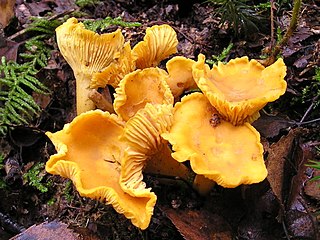
Cantharellus cibarius is a species of golden chanterelle mushroom in the genus Cantharellus. It is also known as girolle. It grows in Europe from Scandinavia to the Mediterranean Basin, mainly in deciduous and coniferous forests. Due to its characteristic color and shape, it is easy to distinguish from mushrooms with potential toxicity that discourage human consumption. A commonly eaten and favored mushroom, the chanterelle is typically harvested from late summer to late fall in its European distribution.
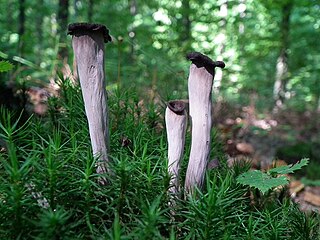
Craterellus is a genus of generally edible fungi similar to the closely related chanterelles, with some new species recently moved from the latter to the former. Both groups lack true gills on the underside of their caps, though they often have gill-like wrinkles and ridges.

Hygrophoropsis aurantiaca, commonly known as the false chanterelle, is a species of fungus in the family Hygrophoropsidaceae. It is found across several continents, growing in woodland and heathland, and sometimes on woodchips used in gardening and landscaping. Fruit bodies (mushrooms) are yellow–orange, with a funnel-shaped cap up to 8 cm across that has a felt-like surface. The thin, often forked gills on the underside of the cap run partway down the length of the otherwise smooth stipe. Reports on the mushroom's edibility vary – it is considered poisonous, but has historically been eaten internationally.
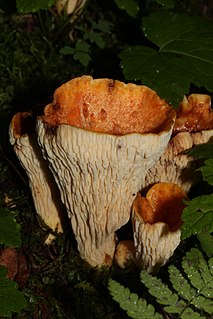
Turbinellus floccosus, commonly known as the scaly vase, or sometimes the shaggy, scaly, or woolly chanterelle, is a cantharelloid mushroom of the family Gomphaceae native to Asia and North America. It was known as Gomphus floccosus until 2011, when it was found to be only distantly related to the genus's type species, G. clavatus. It was consequently transferred from Gomphus to Turbinellus. The orange-capped vase- or trumpet-shaped fruiting bodies may reach 30 cm (12 in) high and 30 cm (12 in) wide. The lower surface, the hymenium, is covered in wrinkles and ridges rather than gills or pores, and is pale buff or yellowish to whitish.
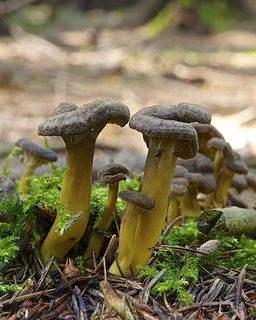
Craterellus tubaeformis is an edible fungus, also known as yellowfoot, winter mushroom, or funnel chanterelle. It is mycorrhizal, forming symbiotic associations with plants, making it very challenging to cultivate. It is smaller than the golden chanterelle and has a dark brown cap with paler gills and a hollow yellow stem. C. tubaeformis tastes stronger but less fruity than the golden chanterelle. It has a very distinctive smokey, peppery taste when raw. It grows in temperate and cold parts of Northern America and Europe, including Scandinavia, Finland, Russia, and the British Isles, as well as in the Himalayas in Asia, including Assam, in the central parts of the Indian subcontinent, and in Thailand.

Gomphus clavatus, commonly known as pig's ears or the violet chanterelle, is an edible species of fungus in the genus Gomphus native to Eurasia and North America. The fruit body is vase- or fan-shaped with wavy edges to its rim, and grows up to 15–16 cm wide and 17 cm tall. The upper surface or cap is orangish-brown to lilac, while the lower spore-bearing surface, the hymenium, is covered in wrinkles and ridges rather than gills or pores, and is a distinctive purple color. Described by Jacob Christian Schäffer in 1774, G. clavatus has had several name changes and many alternative scientific names, having been classified in the genus Cantharellus, though it is not closely related to them.

Polyozellus is a fungal genus in the family Thelephoraceae, a grouping of mushrooms known collectively as the leathery earthfans. A monotypic genus, it contains the single species Polyozellus multiplex, first described in 1899, and commonly known as the blue chanterelle, the clustered blue chanterelle, or, in Alaska, the black chanterelle. The distinctive fruit body of this species comprises blue- to purple-colored clusters of vase- or spoon-shaped caps with veiny wrinkles on the undersurface that run down the length of the stem.

Cantharellus lateritius, commonly known as the smooth chanterelle, is a species of edible fungus in the mushroom family Cantharellaceae. An ectomycorrhizal species, it is found in Asia, Africa, and North America. The species has a complex taxonomic history, and has undergone several name changes since its first description by American mycologist Lewis David de Schweinitz in 1822. The fruit bodies of the fungus are brightly colored yellow to orange, and usually highly conspicuous against the soil in which they are found. At maturity, the mushroom resembles a filled funnel with the spore-bearing surface along the sloping outer sides. The texture of the fertile undersurface (hymenium) of the caps is a distinguishing characteristic of the species: unlike the well-known golden chanterelle, the hymenium of C. lateritius is much smoother. Chemical analysis has revealed the presence of several carotenoid compounds in the fruit bodies.

Lactarius alnicola, commonly known as the golden milkcap, is a species of fungus in the family Russulaceae. The fruit bodies produced by the fungus are characterized by a sticky, vanilla-colored cap up to 20 cm (7.9 in) wide with a mixture of yellow tones arranged in faint concentric bands. The stem is up to 5 cm (2.0 in) long and has yellow-brown spots. When it is cut or injured, the mushroom oozes a white latex, which has an intensely peppery taste. The acrid taste of the fruit bodies renders them unpalatable. The fungus is found in the western United States and Mexico, where it grows in mycorrhizal associations with various coniferous trees species, such as spruce, pine and fir, and deciduous species such as oak and alder. It has also been collected in India. Two varieties have been named: var. pitkinensis, known from Colorado, and var. pungens, from Michigan.

Cantharellus formosus, commonly known as the Pacific golden chanterelle, is a fungus native to the Pacific Northwest region of North America. It is a member of the genus Cantharellus along with other popular edible chanterelles. It was distinguished from the similar C. cibarius of Europe in the 1990s. It is orange to yellow, meaty and funnel-shaped. On the underside of the smooth cap, it has gill-like ridges that run down onto its stipe, which tapers down seamlessly from the cap. The false gills often have a pinkish hue. It has a mild, sweet odor. It is solitary to gregarious in coniferous forests, fruiting from July to December.

Cantharellus subalbidus, the white chanterelle, is a fungus native to California and the Pacific Northwest region of North America. It is a member of the genus Cantharellus along with other popular edible chanterelles. It is similar in appearance to other chanterelles except for its cream to white color and orange bruising.

Cantharellus californicus, sometimes called the mud puppy or oak chanterelle, is a fungus native to California, United States. It is a member of the genus Cantharellus along with other popular edible chanterelles. It is generally similar in appearance to C. cibarius and C. formosus except for its large size at maturity; individual specimens larger than 1 kilogram (2.2 lb) are reported, making it the largest known species of chanterelle. Their unusual size is due in part to their capacity for indeterminate growth, making Cantharellus californicus specimens actively grow for far longer than most other mushrooms.

Cantharellus cascadensis, the Cascade chanterelle, is a fungus native to the Pacific Northwest region of North America. It is a member of the genus Cantharellus along with other popular edible chanterelles. It is named after the Cascade Range, where it was formally described in 2003.
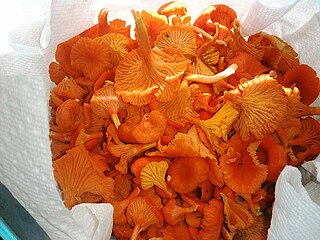
Cantharellus cinnabarinus Greek word meaning cup/ tankard or drinking vessel (or Cinnabar Red Chanterelle- ) is a fungus native to eastern North America. It is a member of the genus Cantharellus along with other chanterelles. It is named after its red color, which is imparted by the carotenoid canthaxanthin. It is edible and good, fruiting in association with hardwood trees in the summer and fall.

Cantharellus minor is a fungus native to eastern North America. It is one of the smallest of the genus Cantharellus, which includes other edible chanterelles. It is suspected of being mycorrhizal, found in association with oaks and moss. Recently, C. minor has been reported from semi-evergreen to evergreen forests in the Western Ghats, Kerala, India forming ectomycorrhizal associations with tree species like Vateria indica, Diospyros malabarica, Hopea parviflora, and Myristica species. The cap of C. minor ranges from 0.5 to 3.0 cm wide and is convex and umbonate, often shallowly depressed, becoming funnel-shaped in some. The yellowish gills are decurrent, and fade to yellowish white in maturity. The stipe is less than 4 cm (1.6 in) tall. They fruit in the summer and fall. Although insubstantial, they are edible.

Turbinellus kauffmanii, is a species of mushroom native to North America.




















